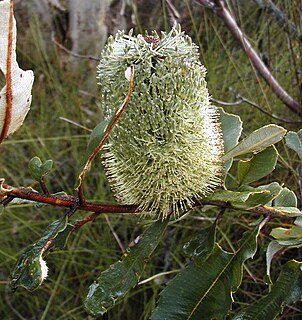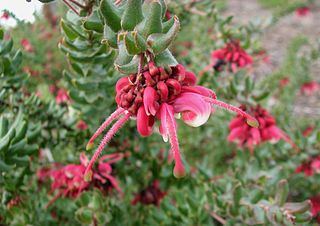
Epacris impressa, also known as common heath, is a plant of the heath family, Ericaceae, that is native to southeast Australia. French botanist Jacques Labillardière collected the species in 1793 and described it in 1805. Four forms have been identified, but no subspecies are recognised. Growing in heathland, shrubland or open forest, it is generally a small shrub around 0.5 to 1 m tall, with small stiff leaves. The red, pink or white tube-like flowers appear from late autumn to early spring. Honeyeater birds, particularly the eastern spinebill, feed upon the nectar of the flowers. It regenerates after bushfire by seed or by resprouting.

A heath is a shrubland habitat found mainly on free-draining infertile, acidic soils and characterised by open, low-growing woody vegetation. Moorland is generally related to high-ground heaths with—especially in Great Britain—a cooler and damper climate.

Erica vagans, the Cornish heath or wandering heath, is a species of flowering plant in the family Ericaceae, native to Ireland, Cornwall, western France and Spain. It is a vigorous, spreading, evergreen heather reaching 75 cm (30 in) tall and wide, with pink flowers borne in racemes 14 cm (6 in) long in summer and autumn. The Latin specific epithet vagans literally means "wandering"; in this context it means "widely distributed".

Banksia aemula, commonly known as the wallum banksia, is a shrub of the family Proteaceae. Found from Bundaberg south to Sydney on the Australian east coast, it is encountered as a shrub or a tree to 8 m (26 ft) in coastal heath on deep sandy soil, known as Wallum. It has wrinkled orange bark and shiny green serrated leaves, with green-yellow flower spikes, known as inflorescences, appearing in autumn. The flower spikes turn grey as they age and large grey follicles appear. Banksia aemula resprouts from its woody base, known as a lignotuber, after bushfires.

Banksia oblongifolia, commonly known as the fern-leaved, dwarf or rusty banksia, is a species in the plant genus Banksia. Found along the eastern coast of Australia from Wollongong, New South Wales in the south to Rockhampton, Queensland in the north, it generally grows in sandy soils in heath, open forest or swamp margins and wet areas. A many-stemmed shrub up to 3 m (9.8 ft) high, it has leathery serrated leaves and rusty-coloured new growth. The yellow flower spikes, known as inflorescences, most commonly appear in autumn and early winter. Up to 80 follicles, or seed pods, develop on the spikes after flowering. Banksia oblongifolia resprouts from its woody lignotuber after bushfires, and the seed pods open and release seed when burnt, the seed germinating and growing on burnt ground. Some plants grow between fires from seed shed spontaneously.

Banksia lullfitzii is a species of shrub that is endemic to the south-west of Western Australia. It has linear leaves with widely-spaced, sharply-pointed teeth on the sides, golden-orange to orange-brown flowers, and later, up to thirty follicles in each head.

Hakea pachyphylla is a flowering plant in the family Proteaceae and is endemic to the upper Blue Mountains in New South Wales. It is a small shrub with stiff, needle-shaped leaves and clusters of yellow flowers. Formerly thought to be a Blue Mountains form of Hakea propinqua.

Galium saxatile or heath bedstraw is a plant species of the genus Galium. It is related to cleavers.

Grevillea baueri, commonly known as Bauer's grevillea, is a species of flowering plant in the family Proteaceae and is endemic to the coastal ranges of south-eastern New South Wales. It is a low, spreading to erect shrub with mostly oblong to egg-shaped leaves with red to pink and cream-coloured or yellow flowers.

Persoonia stradbrokensis is a species of flowering plant in the family Proteaceae and is endemic to eastern Australia. It is an erect shrub or tree with hairy young branchlets, elliptic to egg-shaped leaves, and yellow flowers borne in groups of up to twenty on a rachis up to 100 mm (3.9 in), each flower with a leaf or scale leaf at its base.

Isopogon latifolius is a shrub of the family Proteaceae that is endemic to the southwest botanical province of Western Australia.

Isopogon asper is a species of plant in the family Proteaceae and is endemic to the south-west of Western Australia. It is a low shrub with crowded pinnate leaves and flattened spherical heads of glabrous pink flowers.

Hakea commutata is a shrub in the family Proteaceae native to Western Australia. A variable species in shape and growing requirements, including mallee heath, sand and along creek lines.

Grevillea anethifolia, commonly known as spiny cream spider flower, is a species of flowering plant in the family Proteaceae and is endemic to continental Australia. It is an erect shrub with hairy branchlets, lobed leaves, the lobes sharply pointed, and white to pale yellow or cream-coloured flowers.

Hakea horrida is a shrub in the family Proteacea and is endemic to an area in the Wheatbelt, Great Southern and Goldfields-Esperance regions of Western Australia. It is a small dense shrub, extremely prickly with large creamy white scented flowers.

Petrophile cyathiforma is a species of flowering plant in the family Proteaceae and is endemic to southwestern Western Australia. It is a small shrub with needle-shaped, sharply-pointed leaves and cup-shaped heads of glabrous, bright yellow flowers.

Isopogon scabriusculus is a species of flowering plant in the family Proteaceae and is endemic to southwestern Western Australia. It is a shrub with cylindrical, or narrow flat, sometimes forked leaves, and spherical to oval heads of pink or red flowers.
Grevillea sphacelata, also known as the grey spider flower, is a species of plant in the protea family that is endemic to Australia. The specific epithet sphacelata comes from the Latin for “withered”, with reference to the appearance of the flowers.

Grevillea hortiorum is a species of plant in the protea family that is endemic to Australia.
Grevillea pieroniae is a species of plant in the protea family that is endemic to Australia.


















